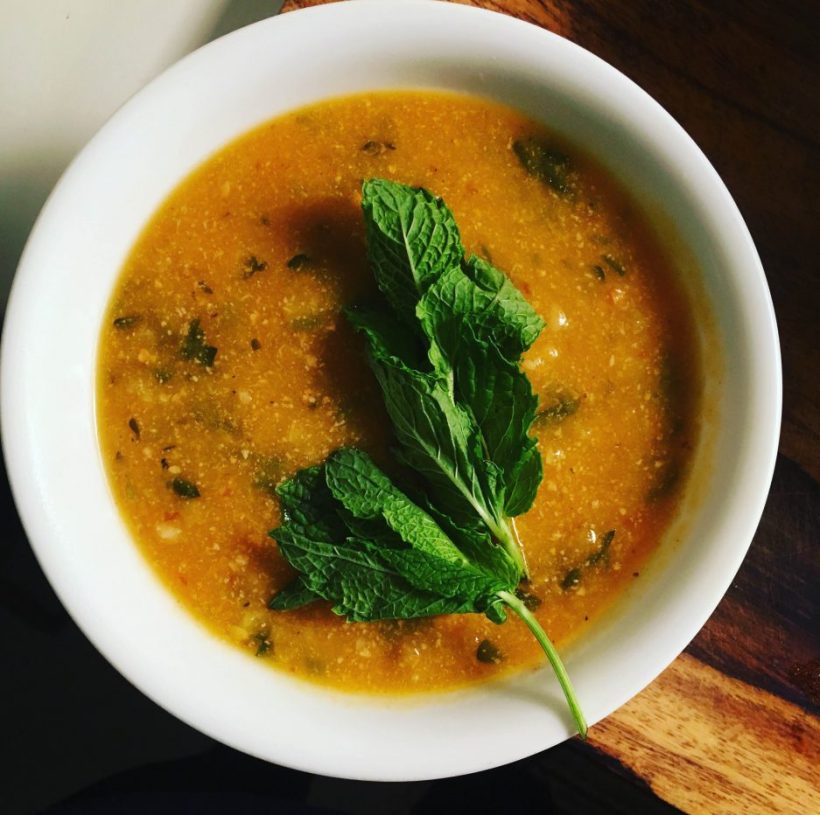 As an assignment for one of my classes this term, we were asked to visit the farmer’s market to acquire something we hadn’t cooked with before. I was excited about the assignment as I LOVE the farmer’s market … any shape or size, I’m into it.
As an assignment for one of my classes this term, we were asked to visit the farmer’s market to acquire something we hadn’t cooked with before. I was excited about the assignment as I LOVE the farmer’s market … any shape or size, I’m into it.
I wanted to visit my friend Rick of Abundant Fields Farm, so I chose to go to the Montavilla market, where I knew he would be. I imagined that he’d have some cool new thing that I could try and ask him about. To my dismay, all his veg looked familiar. What? No Spanish black radish or chrysanthemum leaves today, Rick? Dang.
So, I head out instead to “do a lap.” This amazingly generous girl selling raw desserts next to Rick offers to watch my child for me, and though, no, I do not know her, this is Portland, Oregon, and my friend Rick is in the adjacent booth, so, I agree. Relieved to be on my own, I begin my search. A couple booths in, I see some garlic pork sausage that I really want. I didn’t think that was the sort of thing my instructors had in mind (our prompt asks about where the item is grown). So, I pass. I continue on, booth after booth, and I really don’t see anything new or exciting … until I get to one of the last booths, Fiddlehead Farm. I see a large bunch of something initially unidentifiable. Upon closer look, I realize it’s purslane. A weed! I love that these farmers are doing what we used to do at I farm I worked for in California. We would harvest amaranth and lambs quarters, weeds that grew abundantly and on their own in between and at the ends of row crops, and sold them to customers. I paid $2.50 for a bunch of weeds!!
This picture is from Fiddlehead Farm’s Instagram feed and shows how this weed can really take over a row of crops:
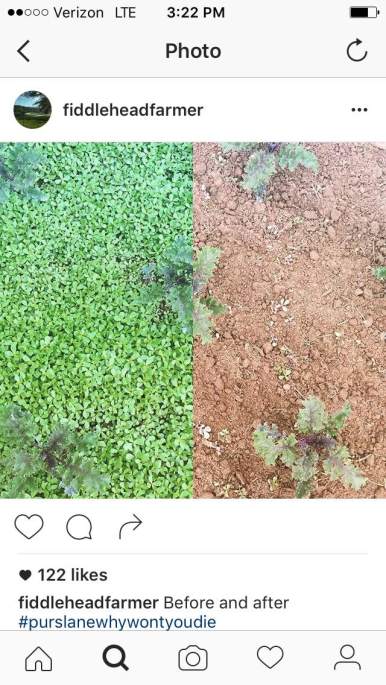
I asked Fiddlehead farmer, Katie Coppoletta, about the purslane. We talked about how it’s found on nearly every farm, without being intentionally grown. I had eaten purslane before, but I had never cooked with it, so I asked if she knew how to prepare it. She said she eats it raw and in salads, which is what I have done. I also know it makes a nice pickle. Then Katie told me that there is a Mexican food cart at the market and that they make a soup with the purslane. This I had to investigate, so I headed over for some tamales and some education.
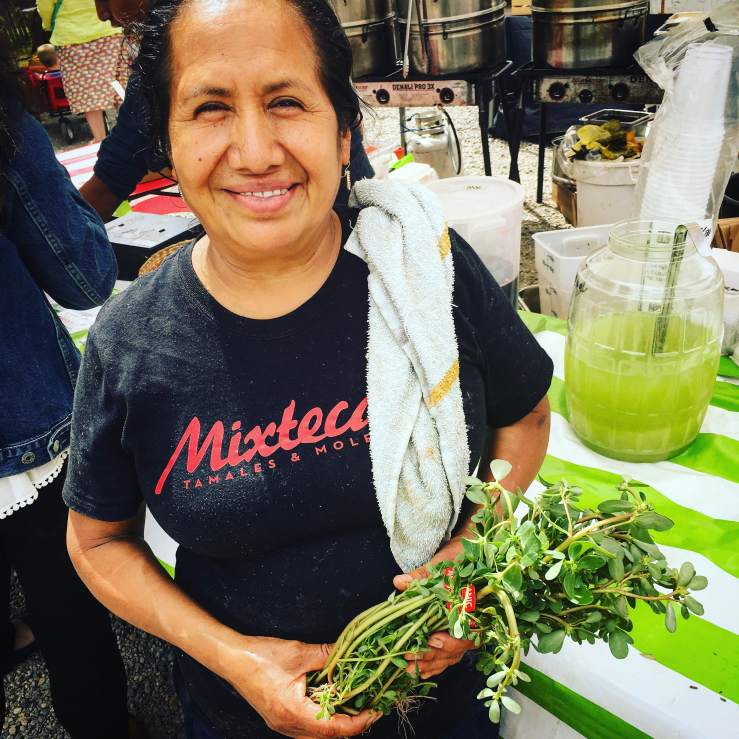
Paola, of Mixteca, and Yuri, who graciously translated, explain that purslane, which is called verdolaga in Spanish, is good for the skin and gut. They tell me to boil it in shallow water for 15 mins and then to add it to eggs, stewed pork or chicken with salsa verde, or chicken or beef broth with a little salt and cilantro. You can also make soups with it and in this case you do not have to precook it. Paola even says you can use the roots as a liver cleanser by making a tea of them.
This got my creative juices going. I went home and did a google search for purslane soup. I found a delicious looking Portuguese soup and because I’m half Portuguese, it struck my fancy. And let me tell you, this recipe is a WINNER! Thank you Tessa Kiros for sharing your genius with the world, and I will now be checking out all of your cookbooks!
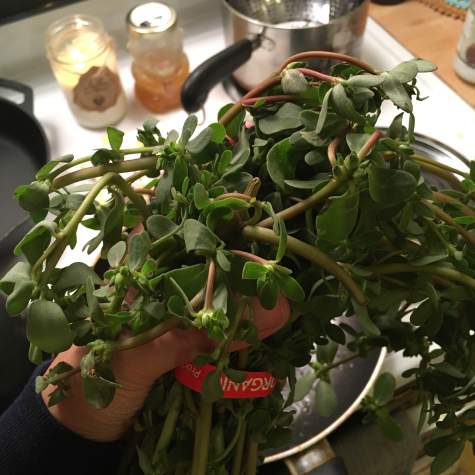
This is Tessa’s amazing recipe, from her book, Piri Piri Starfish: Portugal Found, with some of my notes to the side.
Purslane Soup
From Piri Piri Starfish by Tessa Kiros
(Makes about 1.75 litres / 61 fl oz / 7 cups)
2 Tbsp Olive Oil
1 Tbsp butter
1 large onion, roughly chopped (I used half a large)
1 carrot, peeled and chopped (definitely did not peel)
40g (1 1/2 oz) chourico or spicy sausage, cut into 2-3 slices (this turned out to be only 1/3 of a sausage link, so I used the whole link, without the casing)
2 garlic cloves, roughly chopped
3 Tbsp white wine
600g (1 lb 5 oz) potatoes, peeled and halved (I used half sweet potatoes and chopped them all, which reduced cooking time)
2-3 tsps coarse salt
85g (3oz / heaped 1/3 cup) parboiled variety of rice (I cooked brown basmati to half-done)
125g (4 1/2 oz) purslane leaves
1/2 tsp ground cinnamon
juice of half a lemon
10 fresh mint leaves, to serve
Heat the oil and butter in a large stockpot and sauté the onion until softened and golden. Add the carrot and chourico and sauté for a while longer until it smells good, then add the garlic and cook until you can smell it.
Add the wine and cook until almost evaporated. Add the potato, salt and a couple of twists of pepper, turning it through with a wooden spoon and sautéing for a couple of minutes more.

Add 1.5 litres (52 fl oz / 6 cups) of homemade chicken broth. Bring to the boil, lower the heat slightly, cover the pot and cook at a high simmer for 20 minutes or so. Remove from the heat.
With a slotted spoon, scoop out the potatoes into a bowl (I skipped this step). Take out the chourico slices (skipped this one, too). Purée until smooth.
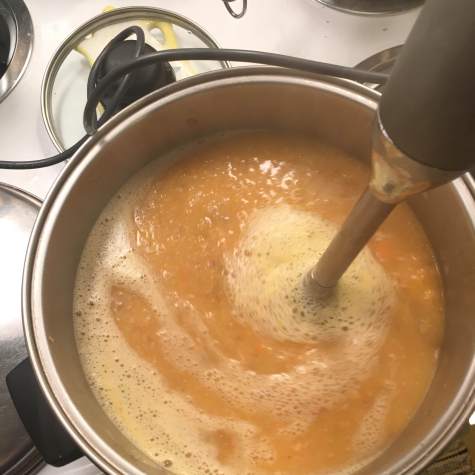
Add the rice to the pot and bring back to the boil, stirring with a wooden spoon to make sure it doesn’t stick. Add the purslane, bring back to the boil, then simmer uncovered for another 20 minutes or so until the rice is just cooked.
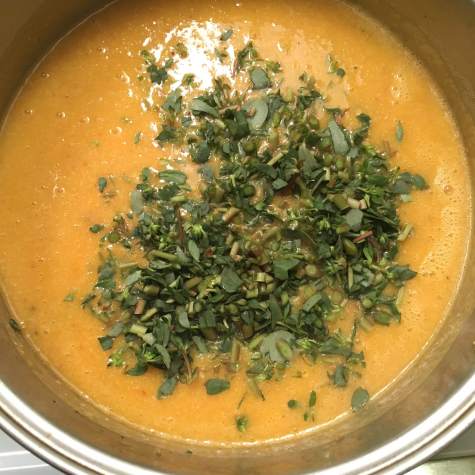
Stir the thickened pup every now and then to make sure it is not sticking. Stir in the cinnamon, to taste, and the lemon juice. Serve hot, with mint leaves on top. Enjoy! This soup was easy to prepare, hearty, and super tasty. Next time I will probably double the amount of purslane as I think it could have used more.
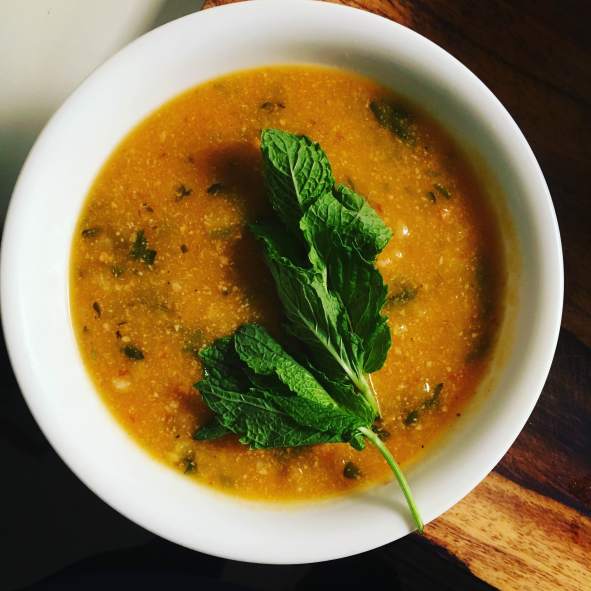
Some additional Information about Purslane:
What I found about purslane’s nutritional content is that much of the vitamin content goes up when you cook it. While many sources all varying information, here is a breakdown I found that looked mostly consistent with what I was reading:
Per 1 cup purslane, boiled:
Calories: 21
Total Fat: 0.2g
Total Carbs: 4.1g
Protein: 1.7g
Vitamin A: 42% DV
Vitamin C: 20%
Magnesium: 19%
Calcium: 9%
Vitamin B6: 5%
Iron: 4%
Source: USDA, https://ndb.nal.usda.gov/ndb/search/list?qlookup=11427
Purslane is considered one of the highest, if not the highest, plant-based source of essential Omega-3 fatty acids, especially good for heart health and brain function. It is also a rich source of fiber and Vitamins A, E, C, and the B family. It is suggested that purslane contains 6 times more vitamin E than spinach and 7 times the beta carotene content of carrots. It is also a good source of magnesium (good for brain health and mood), calcium (for strong bones and essential for bodily functions), folate, potassium (keeps blood pressure down as a vasodilator), lithium (for sanity), iron (for increased oxygen transport and red blood cell production), and protein (for maintenance, growth and repair).
Green Deane (of Eat The Weeds) recommends pickling this nutrient powerhouse:
1 quart purslane stems and leaves
3 garlic cloves, sliced
1 quart apple cider vinegar
10 peppercorns
Clean the purslane stems and leaves by rinsing with fresh water. Cut into 1″ pieces and place in clean jars with lids. Add the spices and pour the vinegar over the purslane. Keep this in the refrigerator and wait at least two weeks before using. Serve as a side dish with omelets and sandwiches. You can pickle the purslane raw or blanche it for two minutes in boiling water first, but cool off quickly in ice water.
Source: Eat The Weeds, http://www.eattheweeds.com/purslane-omega-3-fatty-weed/
Purslane is named the FDA’s 7th worst pervasive weed in Agriculture. According to Mother Earth News, it will grow anywhere that has at least a 2-month window, although usually the growth is NOT intended by the farmer. It’s been used medicinally since medieval times for a “burning” or heart or liver. Pliny the Elder used to recommend wearing the plant as an amulet against evil. Purslane is widely used in Mediterranean countries and is common in India. Recipes using this nutrient-dense food are popular in Greece, Turkey, Lebanon, Albania, Portugal and Pakistan. It’s tart flavor lends itself to being a nice foil to sweeter (i.e.: potatoes, beets, fava beans, garbanzos) or more juicy veg (cucumbers, tomatoes).
Sources: Mother Earth News, http://www.motherearthnews.com/organic-gardening/power-packed-purslane-zmaz05amzsel.aspx. The Weston A. Price Foundation, http://www.westonaprice.org/health-topics/purslane/
Rosemary Gladstar’s Horta for Liver and Kidney Health
This dish originated in Greece and is enjoyed throughout the Mediterranean. Horta can be enjoyed as an accompaniment to any meal or used medicinally to help with liver and digestive issues. It is easy to digest and very nourishing, good for when you need a good energy/nutrient boost.
-Gather fresh dandelion greens, nettles, purslane, and other wild greens.
-Steam for 5-8 minutes, or until well wilted.
-Drain and place herbs in a bowl with a drizzle of olive oil and some fresh lemon juice to taste.
-Add a bit of crumbled feta cheese on top if you like.
Source: Rosemary Gladstar’s Medicinal Herbs, A Beginner’s Guide
Other uses not previous mentioned: Add raw to sandwiches, make into a pesto with basil, stir-fry, or cook down solo with some garlic and serve with a drizzle of olive oil and sea salt.
Another tidbit: Purslane harvested in the early morning, as opposed to late afternoon, may have 10 times the malic acid yielding a more tangy flavor.
Source: The Weston A. Price Foundation, http://www.westonaprice.org/health-topics/purslane/
Summary:
I LOVED reading about all the amazing nutrients and health benefits attributed to this plant. I am excited to help people to identify, harvest, prepare and enjoy this incredible edible! This would make an amazing container plant for people with limited space, time, financial resources. And, If you befriend a farmer, you could likely have an abundant source for free!
Cooking with it was easier than I expected. The next time I make the soup I will be doubling the amount of purslane as I feel it could have had more of a presence, adding too, all of it’s vitamins and nutrients. I am also eager to experiment more with culinary and medicinal recipes with purslane so that I can bring them to the people!
Thanks for such a fun assignment!!
-Carissa Pereira, 8/11/2016. Mailbox: M850
LikeLike
Wow great job Car, I’m going to try the recipes 💕
LikeLike